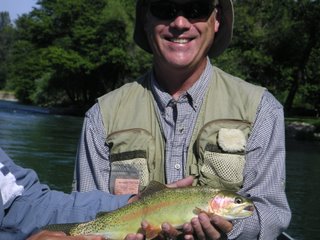Fishing in Redding
Last week the Troutwife and I took a trip to Redding, and spent a day drifting flies down the lower Sacramento.
Here's the big fish of the day:

And another:

The technique used by our Redding guide, Lonnie Boles, is the "dead drift." A yarn strike indicator is used, along with about 8 feet of leader and tippet. Three flies are attached, one after another. We had a puffball salmon egg fly on top, as an attractor fly, and two nymphs below. A split shot was in there somewhere. The rig is a bit ungainly to cast, but once you get it in the water, you mend it so the bow in the (floating) line is pointed upstream. The flies are then working roughly parallel to the boat as it drifts downstream. Anytime the strike indicator sinks, set the hook hard.
It took a while to get the hang of it, but once we did, we started catching fish. The Fly Shop in Redding says the average rainbow in the lower Sac is sixteen inches, but that was the size of our largest fish. I reserve judgment on this until I've tried it again. Lonnie was a great guide, friendly and patient, and eager for us to do well.
We also spent a couple of days in Trinity County, west of Redding. I was hoping some of the smaller streams would be fishable, but everything was blown out. We tried Lewiston Lake, and got skunked. But some of the locals have a great sense of humor:

We took a look at the Trinity River, which was running pretty high:

The release has been like this for weeks and will continue for a while. Biologists hope the high flows will clear some of the historic spawning beds of silt, and remove a lot of vegetation, so the river will be more like what it was in the days before the dams. Along with some mechanical rearrangement of the riverbed done in low flow periods, biologists hope the high flows will bring the anadromous fish populations to sixty percent of pre-dam numbers. If it works, we will all have some fine fishing in our old age.
Last week the Troutwife and I took a trip to Redding, and spent a day drifting flies down the lower Sacramento.
Here's the big fish of the day:

And another:

The technique used by our Redding guide, Lonnie Boles, is the "dead drift." A yarn strike indicator is used, along with about 8 feet of leader and tippet. Three flies are attached, one after another. We had a puffball salmon egg fly on top, as an attractor fly, and two nymphs below. A split shot was in there somewhere. The rig is a bit ungainly to cast, but once you get it in the water, you mend it so the bow in the (floating) line is pointed upstream. The flies are then working roughly parallel to the boat as it drifts downstream. Anytime the strike indicator sinks, set the hook hard.
It took a while to get the hang of it, but once we did, we started catching fish. The Fly Shop in Redding says the average rainbow in the lower Sac is sixteen inches, but that was the size of our largest fish. I reserve judgment on this until I've tried it again. Lonnie was a great guide, friendly and patient, and eager for us to do well.
We also spent a couple of days in Trinity County, west of Redding. I was hoping some of the smaller streams would be fishable, but everything was blown out. We tried Lewiston Lake, and got skunked. But some of the locals have a great sense of humor:

We took a look at the Trinity River, which was running pretty high:

The release has been like this for weeks and will continue for a while. Biologists hope the high flows will clear some of the historic spawning beds of silt, and remove a lot of vegetation, so the river will be more like what it was in the days before the dams. Along with some mechanical rearrangement of the riverbed done in low flow periods, biologists hope the high flows will bring the anadromous fish populations to sixty percent of pre-dam numbers. If it works, we will all have some fine fishing in our old age.
